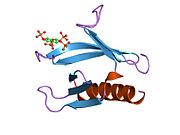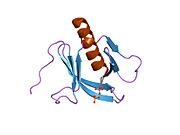DAPP1
Protein-coding gene in the species Homo sapiens
| DAPP1 | |||||||||||||||||||||||||||||||||||||||||||||||||||
|---|---|---|---|---|---|---|---|---|---|---|---|---|---|---|---|---|---|---|---|---|---|---|---|---|---|---|---|---|---|---|---|---|---|---|---|---|---|---|---|---|---|---|---|---|---|---|---|---|---|---|---|
 | |||||||||||||||||||||||||||||||||||||||||||||||||||
| |||||||||||||||||||||||||||||||||||||||||||||||||||
| Identifiers | |||||||||||||||||||||||||||||||||||||||||||||||||||
| Aliases | DAPP1, BAM32, dual adaptor of phosphotyrosine and 3-phosphoinositides, dual adaptor of phosphotyrosine and 3-phosphoinositides 1 | ||||||||||||||||||||||||||||||||||||||||||||||||||
| External IDs | OMIM: 605768; MGI: 1347063; HomoloGene: 32138; GeneCards: DAPP1; OMA:DAPP1 - orthologs | ||||||||||||||||||||||||||||||||||||||||||||||||||
| |||||||||||||||||||||||||||||||||||||||||||||||||||
| |||||||||||||||||||||||||||||||||||||||||||||||||||
| |||||||||||||||||||||||||||||||||||||||||||||||||||
| |||||||||||||||||||||||||||||||||||||||||||||||||||
| |||||||||||||||||||||||||||||||||||||||||||||||||||
| Wikidata | |||||||||||||||||||||||||||||||||||||||||||||||||||
| |||||||||||||||||||||||||||||||||||||||||||||||||||
Dual adapter for phosphotyrosine and 3-phosphotyrosine and 3-phosphoinositide is a protein that in humans is encoded by the DAPP1 gene.[5][6]
References
- ^ a b c GRCh38: Ensembl release 89: ENSG00000070190 – Ensembl, May 2017
- ^ a b c GRCm38: Ensembl release 89: ENSMUSG00000028159 – Ensembl, May 2017
- ^ "Human PubMed Reference:". National Center for Biotechnology Information, U.S. National Library of Medicine.
- ^ "Mouse PubMed Reference:". National Center for Biotechnology Information, U.S. National Library of Medicine.
- ^ Dowler S, Currie RA, Downes CP, Alessi DR (Oct 1999). "DAPP1: a dual adaptor for phosphotyrosine and 3-phosphoinositides". Biochem J. 342 (1): 7–12. doi:10.1042/0264-6021:3420007. PMC 1220429. PMID 10432293.
- ^ "Entrez Gene: DAPP1 dual adaptor of phosphotyrosine and 3-phosphoinositides".
Further reading
- Bonaldo MF, Lennon G, Soares MB (1997). "Normalization and subtraction: two approaches to facilitate gene discovery". Genome Res. 6 (9): 791–806. doi:10.1101/gr.6.9.791. PMID 8889548.
- Marshall AJ, Niiro H, Lerner CG, et al. (2000). "A novel B lymphocyte-associated adaptor protein, Bam32, regulates antigen receptor signaling downstream of phosphatidylinositol 3-kinase". J. Exp. Med. 191 (8): 1319–32. doi:10.1084/jem.191.8.1319. PMC 2193139. PMID 10770799.
- Dowler S, Montalvo L, Cantrell D, et al. (2001). "Phosphoinositide 3-kinase-dependent phosphorylation of the dual adaptor for phosphotyrosine and 3-phosphoinositides by the Src family of tyrosine kinase". Biochem. J. 349 (Pt 2): 605–10. doi:10.1042/0264-6021:3490605. PMC 1221184. PMID 10880360.
- Ferguson KM, Kavran JM, Sankaran VG, et al. (2000). "Structural basis for discrimination of 3-phosphoinositides by pleckstrin homology domains". Mol. Cell. 6 (2): 373–84. doi:10.1016/S1097-2765(00)00037-X. PMID 10983984.
- Dowler S, Currie RA, Campbell DG, et al. (2001). "Identification of pleckstrin-homology-domain-containing proteins with novel phosphoinositide-binding specificities". Biochem. J. 351 (Pt 1): 19–31. doi:10.1042/0264-6021:3510019. PMC 1221362. PMID 11001876.
- Zhang QH, Ye M, Wu XY, et al. (2001). "Cloning and functional analysis of cDNAs with open reading frames for 300 previously undefined genes expressed in CD34+ hematopoietic stem/progenitor cells". Genome Res. 10 (10): 1546–60. doi:10.1101/gr.140200. PMC 310934. PMID 11042152.
- Stephens LR, Anderson KE, Hawkins PT (2001). "Src family kinases mediate receptor-stimulated, phosphoinositide 3-kinase-dependent, tyrosine phosphorylation of dual adaptor for phosphotyrosine and 3-phosphoinositides-1 in endothelial and B cell lines". J. Biol. Chem. 276 (46): 42767–73. doi:10.1074/jbc.M107194200. PMID 11524430.
- Niiro H, Maeda A, Kurosaki T, Clark EA (2002). "The B lymphocyte adaptor molecule of 32 kD (Bam32) regulates B cell antigen receptor signaling and cell survival". J. Exp. Med. 195 (1): 143–9. doi:10.1084/jem.20011524. PMC 2196019. PMID 11781373.
- Marshall AJ, Krahn AK, Ma K, et al. (2002). "TAPP1 and TAPP2 are targets of phosphatidylinositol 3-kinase signaling in B cells: sustained plasma membrane recruitment triggered by the B-cell antigen receptor". Mol. Cell. Biol. 22 (15): 5479–91. doi:10.1128/MCB.22.15.5479-5491.2002. PMC 133950. PMID 12101241.
- Strausberg RL, Feingold EA, Grouse LH, et al. (2003). "Generation and initial analysis of more than 15,000 full-length human and mouse cDNA sequences". Proc. Natl. Acad. Sci. U.S.A. 99 (26): 16899–903. Bibcode:2002PNAS...9916899M. doi:10.1073/pnas.242603899. PMC 139241. PMID 12477932.
- Han A, Saijo K, Mecklenbräuker I, et al. (2003). "Bam32 links the B cell receptor to ERK and JNK and mediates B cell proliferation but not survival". Immunity. 19 (4): 621–32. doi:10.1016/S1074-7613(03)00275-9. PMID 14563325.
- Allam A, Niiro H, Clark EA, Marshall AJ (2004). "The adaptor protein Bam32 regulates Rac1 activation and actin remodeling through a phosphorylation-dependent mechanism". J. Biol. Chem. 279 (38): 39775–82. doi:10.1074/jbc.M403367200. PMID 15247305.
- Gerhard DS, Wagner L, Feingold EA, et al. (2004). "The status, quality, and expansion of the NIH full-length cDNA project: the Mammalian Gene Collection (MGC)". Genome Res. 14 (10B): 2121–7. doi:10.1101/gr.2596504. PMC 528928. PMID 15489334.
- Niiro H, Allam A, Stoddart A, et al. (2004). "The B lymphocyte adaptor molecule of 32 kilodaltons (Bam32) regulates B cell antigen receptor internalization". J. Immunol. 173 (9): 5601–9. doi:10.4049/jimmunol.173.9.5601. PMID 15494510.
- v
- t
- e
PDB gallery
-
 1fao: STRUCTURE OF THE PLECKSTRIN HOMOLOGY DOMAIN FROM DAPP1/PHISH IN COMPLEX WITH INOSITOL 1,3,4,5-TETRAKISPHOSPHATE
1fao: STRUCTURE OF THE PLECKSTRIN HOMOLOGY DOMAIN FROM DAPP1/PHISH IN COMPLEX WITH INOSITOL 1,3,4,5-TETRAKISPHOSPHATE -
 1fb8: STRUCTURE OF THE PLECKSTRIN HOMOLOGY DOMAIN FROM DAPP1/PHISH
1fb8: STRUCTURE OF THE PLECKSTRIN HOMOLOGY DOMAIN FROM DAPP1/PHISH
 | This article on a gene on human chromosome 4 is a stub. You can help Wikipedia by expanding it. |
- v
- t
- e





















